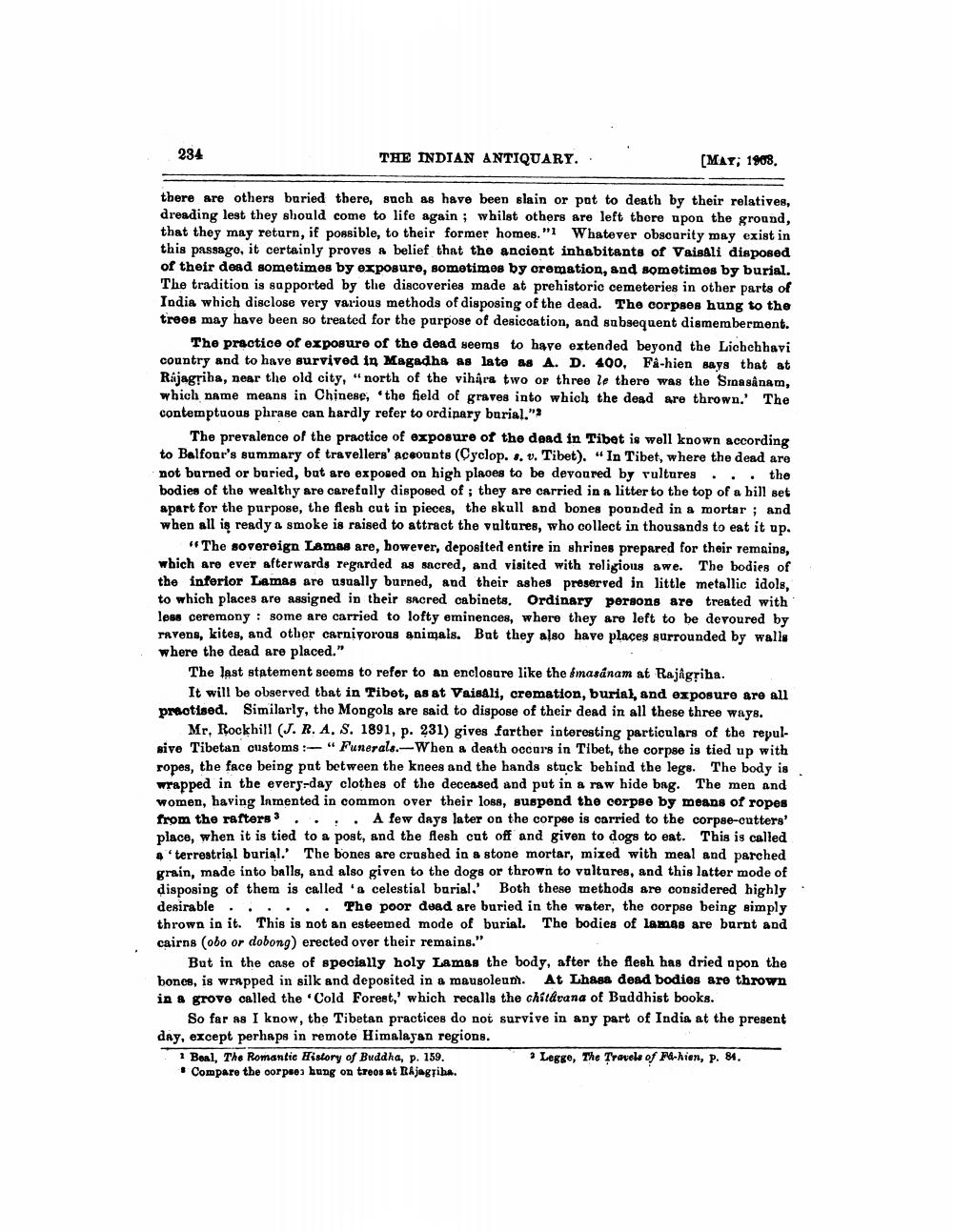________________
234
THE INDIAN ANTIQUARY..
[MAY; 1908.
there are others buried there, such as have been blain or pat to death by their relatives, dreading lest they should come to life again ; whilst others are left there apon the ground, that they may return, if possible, to their former homes. "I Whatever obscurity may exist in this passago, it certainly proves a belief that the ancient inhabitants of Vaisali disposed of their dead sometimes by exposure, sometimes by cremation, and sometimes by burial. The tradition is sapported by the discoveries made at prehistoric cemeteries in other parts of India which disclose very various methods of disposing of the dead. The corpses hung to the trees may have been so treated for the purpose of desiccation, and subsequent dismemberment.
The practice of exposure of the dead seems to have extended beyond the Lichchhavi country and to have survived in Magadha as late as A. D. 400, Fa-hien says that at Rajagriba, near the old city, "north of the vihara two or three le there was the Sra sânam, which name means in Chinese, the field of graves into which the dead are thrown. The contemptuous phrase can hardly refer to ordinary burial."
The prevalence of the practice of exposure of the dead in Tibet is well known according to Balfour's summary of travellers' aceounts (Cyclop... v. Tibet), "In Tibet, where the dead are not burned or buried, but are exposed on high places to be devoured by rultures... the bodies of the wealthy are carefully disposed of; they are carried in a litter to the top of a bill set apart for the purpose, the flesh cut in pieces, the skull and bones pounded in a mortar ; and when all is ready a smoke is raised to attract the valtares, who collect in thousands to eat it up.
"The sovereign Lamas are, however, deposited entire in shrines prepared for their remains, which are ever afterwards regarded as sacred, and visited with religious awe. The bodies of the inferior Lamas are usually burned, and their ashes preserved in little metallic idols, to which places are assigned in their sacred cabinets. Ordinary persons are treated with less ceremony : some are carried to lofty eminences, where they are left to be devoured by TAYONS, kites, and other carnivorous animals. Bat they also have places surrounded by walls where the dead are placed."
The last statement seems to refer to an enclosure like the masánam at Rajâgriba.
It will be observed that in Tibot, as at Vaisali, cremation, burial, and exposure are all practised. Similarly, the Mongols are said to dispose of their dead in all these three ways.
Mr, Rockhill (J. R. A. S. 1891, p. 231) gives farther interesting particulars of the repulsive Tibetan customs "Funerals.-When a death occurs in Tibet, the corpse is tied up with ropes, the face being put between the knees and the hands stuck behind the lege. The body is wrapped in the every day clothes of the deceased and put in a raw hide bag. The men and women, having lamented in common over their loss, suspend the corpse by means of ropes from the rafters .... A few days later on the corpee is carried to the corpse-cutters' place, when it is tied to a post, and the flesh cut off and given to dogs to eat. This is called & 'terrestrial burial.' The bones are crushed in a stone mortar, mixed with meal and parched grain, made into balls, and also given to the dogs or thrown to vultures, and this latter mode of disposing of them is called 'a celestial burial,' Both these methods are considered highly. desirable ...... The poor dead are buried in the water, the corpse being simply thrown in it. This is not an esteemed mode of burial. The bodies of lamas are burnt and cairns (obo or dobong) erected over their remains."
But in the onse of specially holy Lamas the body, after the flesh has dried upon the bones, is wrapped in silk and deposited in a mausoleum. At Lhasa dead bodies are thrown in a grove called the Cold Forest,' which recalls the chitdvana of Buddhist books.
So far as I know, the Tibetan practices do not survive in any part of India at the present day, except perhaps in remote Himalayan regions. 1 Baal, The Romantic History of Buddha, p. 159.
Leggo, The Travels of Pe-hien, p. 84. . Compare the corpse hung on troos at Rhjagriba.




